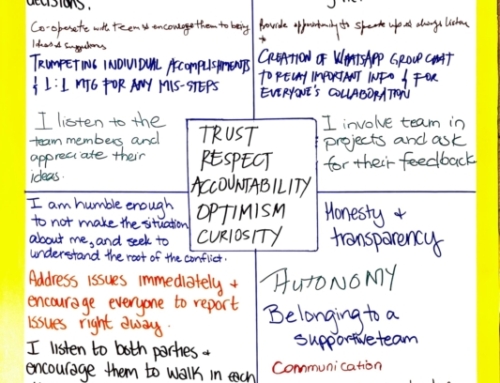People Procrastinate – And Coaching Can Help!
Over the past few weeks, I have been privileged to work with clients across BC, including first responder agencies, a local government department, and an engineering firm. Despite the diversity of these work environments, a common theme echoed through every conversation: procrastination.
For some, the challenge was juggling an overwhelming list of responsibilities and to-dos that left little room for progress. For others, it wasn’t the workload—it was the inertia. Getting started felt most challenging.
In our workshops, we explored how to gently and effectively support someone overcoming procrastination in our role as leaders/coaches. Since this has resonated with so many, why wait to share it with you? (Why procrastinate?)
Step 1: Prepare for the Procrastination Conversation (but not forever :-)
Trust me, this moment won’t work well if you wing it. I’ve done it before, and it usually ends in regret. Something gets miscommunicated, or the message lands wrong.
Set yourself (and them) up for success:
- Gather relevant examples: Are there missed deadlines, avoided tasks, or stalled progress toward goals?
- Get clear on your intention: Your goal isn’t to criticize—it’s to support. Come in with a mindset like: “I believe in your potential, and I’m here to help uncover what might be getting in the way.“ Think of Carol Dweck’s work on growth vs. fixed mindsets.
- Create psychological safety: Choose a private, distraction-free setting. Respect that uninterrupted time—it clearly conveys that this conversation matters.
Step 2: Initiate with Compassionate Curiosity
I’d love to take credit for that phrase, but it comes from one of my favorite speakers, Kwame Christian. (If you haven’t seen his TEDx talk—add it to your watchlist.)
Start the conversation with empathy and shared goals. Here’s a possible opener:
“I’d love to check in with you about your progress on some goals. You’ve set some ambitious targets that really align with what we’re trying to achieve as a team. I also know that even highly motivated people hit blocks or feel overwhelmed. Can we talk about what’s been working—and where you might be feeling stuck?”
Tips to keep in mind:
- Normalize procrastination. (Confession: I meant to write this article last week, but, well, what can I say? Life got in the way.)
- Use neutral, non-blaming language.
- Emphasize collaboration: “Let’s explore this together.”
Step 3: Explore the Underlying Causes
Now, it’s time to shift into coaching mode. Ask open-ended, reflective questions that invite introspection. Your goal isn’t to provide answers—it’s to help the other person uncover them.
Here are a few powerful prompts:
- “What parts of the work do you often put off?”
- “What tends to happen—internally or externally—before you delay starting?”
- “Is it a matter of time, clarity, confidence, or lack of interest?”
- “What story are you telling yourself about this task that might be holding you back?”
- “How do you feel when you finally take action? What helps you move past the hesitation?”
Remember: Procrastination is rarely laziness. It often stems from fear, lack of clarity, or a lack of connection to purpose. These questions go beyond the surface and might even prompt personal reflection as you read them.
Step 4: Reconnect to Purpose and Possibility
Once they’ve unpacked the “why“ behind their procrastination, it’s time to help them re-anchor to purpose and ownership.
Try asking:
- “What was your motivation when you first set this goal?”
- “What impact do you hope to have through this work?”
Then go deeper:
- “If nothing changes, what’s at risk?”
- “If you break through this—even in a small way—what becomes possible?”
The mindset shift begins at this point. From stuck to striving. From fixed to growth.
Step 5: Co-Create Personalized Action Steps
Momentum beats perfection—every time.
As a recovering perfectionist, I’ve made peace with 70% being good enough. It frees me to act instead of overanalyzing. As Brené Brown says:
“Perfectionism is a twenty-ton shield we lug around thinking it will protect us when, in fact, it’s the thing that’s really preventing us from taking flight.”
Here’s how you can help someone move forward:
- Break goals into tiny, time-bound chunks: “What’s one piece of this you can work on for 15 minutes today?”
- Time-block deep work: “Would it help to schedule focused, distraction-free time?”
- Add accountability: “Would a quick weekly check-in help you stay on track?”
- Remove friction: “What’s one thing you could delegate—or say no to—that would free up energy?”
- Reframe the mindset: “What would it look like to aim for progress over perfection?”
Step 6: Wrap Up with Encouragement and Recommitment
Close with appreciation and belief.
“Thank you for being open and reflective—it takes courage to look at this honestly. I’m confident you’ve got what it takes to move forward. What commitment do you want to make as your next step?”
And then:
“Let’s check in again [choose a date/time] and see how it’s going. I’m here to support you—we’re in this together.”
Final Thought: Procrastination Isn’t a Flaw—It’s a Signal
As a coach or leader, your role isn’t to push—it’s to guide. Replace judgment with curiosity, pressure with support, and confusion with clarity.
And if you’re looking for a practical takeaway, try this technique we often refer to in our workshops:
The Seinfeld Technique
This simple method helps build consistency through daily habits:
- Pick one valuable daily action—something realistic and meaningful.
- Use a calendar, notebook, or app to track each day you complete it.
- Anchor it to an existing routine, like right after lunch.
- Protect the streak. Before accepting tasks or invites, ask yourself: “Will this break my chain?”
“Your only job is not to break the chain.“ – Jerry Seinfeld.






